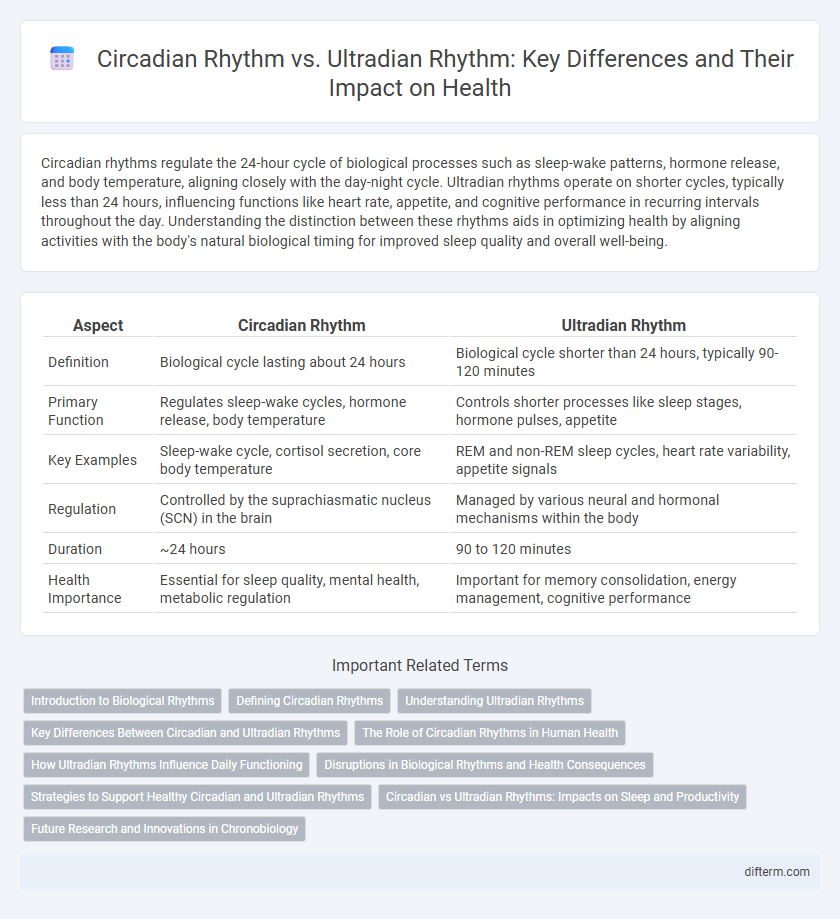Circadian rhythms regulate the 24-hour cycle of biological processes such as sleep-wake patterns, hormone release, and body temperature, aligning closely with the day-night cycle. Ultradian rhythms operate on shorter cycles, typically less than 24 hours, influencing functions like heart rate, appetite, and cognitive performance in recurring intervals throughout the day. Understanding the distinction between these rhythms aids in optimizing health by aligning activities with the body's natural biological timing for improved sleep quality and overall well-being.
Table of Comparison
| Aspect | Circadian Rhythm | Ultradian Rhythm |
|---|---|---|
| Definition | Biological cycle lasting about 24 hours | Biological cycle shorter than 24 hours, typically 90-120 minutes |
| Primary Function | Regulates sleep-wake cycles, hormone release, body temperature | Controls shorter processes like sleep stages, hormone pulses, appetite |
| Key Examples | Sleep-wake cycle, cortisol secretion, core body temperature | REM and non-REM sleep cycles, heart rate variability, appetite signals |
| Regulation | Controlled by the suprachiasmatic nucleus (SCN) in the brain | Managed by various neural and hormonal mechanisms within the body |
| Duration | ~24 hours | 90 to 120 minutes |
| Health Importance | Essential for sleep quality, mental health, metabolic regulation | Important for memory consolidation, energy management, cognitive performance |
Introduction to Biological Rhythms
Biological rhythms regulate various physiological processes, with circadian rhythms operating on a roughly 24-hour cycle, influencing sleep-wake patterns, hormone secretion, and body temperature. Ultradian rhythms occur in shorter cycles, typically less than 24 hours, and govern functions like appetite, heart rate, and attention spans. Understanding these endogenous rhythms is crucial for optimizing health, productivity, and overall well-being.
Defining Circadian Rhythms
Circadian rhythms are natural, internal processes that regulate the sleep-wake cycle and repeat approximately every 24 hours, influenced primarily by light exposure. These rhythms control various physiological functions such as hormone release, body temperature, and metabolism, aligning them with the day-night cycle. Disruption in circadian rhythms can lead to sleep disorders, metabolic issues, and impaired cognitive function.
Understanding Ultradian Rhythms
Ultradian rhythms are biological cycles shorter than 24 hours, typically ranging from 90 minutes to a few hours, regulating processes like hormone release, heart rate, and sleep stages. Unlike the circadian rhythm, which controls the 24-hour sleep-wake cycle, ultradian rhythms influence fluctuating patterns of alertness and cognitive performance throughout the day. Understanding ultradian rhythms helps optimize work-rest intervals and improve overall health by aligning activities with these natural biological pulses.
Key Differences Between Circadian and Ultradian Rhythms
Circadian rhythms regulate bodily functions on a roughly 24-hour cycle, influencing sleep-wake patterns, hormone release, and body temperature, while ultradian rhythms operate within shorter cycles, typically lasting less than 24 hours, such as the 90-120 minute sleep cycles or hormone secretion bursts. Circadian rhythms are primarily governed by the suprachiasmatic nucleus in the brain's hypothalamus and respond to external cues like light and darkness, whereas ultradian rhythms are controlled by neural and hormonal mechanisms independent of light exposure. Understanding these key differences aids in optimizing sleep hygiene, improving mental alertness, and managing conditions like shift work disorder or chronic fatigue.
The Role of Circadian Rhythms in Human Health
Circadian rhythms regulate the 24-hour cycles of physiological processes such as sleep-wake patterns, hormone secretion, and body temperature, playing a crucial role in maintaining overall health and homeostasis. Disruptions in circadian rhythms are linked to increased risks of metabolic disorders, cardiovascular diseases, and mental health conditions like depression and anxiety. Synchronizing behavior and environmental cues with natural circadian cycles enhances immune function, cognitive performance, and metabolic efficiency.
How Ultradian Rhythms Influence Daily Functioning
Ultradian rhythms, which cycle every 90 to 120 minutes, significantly influence daily functioning by regulating energy levels, cognitive performance, and hormonal fluctuations throughout the day. These shorter biological cycles determine periods of heightened alertness and natural breaks, impacting productivity and focus. Understanding ultradian rhythms helps optimize work-rest schedules for improved mental clarity and overall health.
Disruptions in Biological Rhythms and Health Consequences
Disruptions in circadian and ultradian rhythms significantly impair physiological homeostasis, leading to increased risks of metabolic disorders, cardiovascular diseases, and mental health issues such as depression and anxiety. Circadian misalignment, often caused by irregular sleep patterns or shift work, disturbs hormone secretion, including melatonin and cortisol, thereby affecting immune function and cognitive performance. Similarly, ultradian rhythm disturbances disrupt essential cycles like hormone pulsatility and appetite regulation, exacerbating chronic fatigue and digestive problems.
Strategies to Support Healthy Circadian and Ultradian Rhythms
Maintaining healthy circadian and ultradian rhythms involves regular sleep schedules aligned with natural light-dark cycles and incorporating short, frequent breaks during work to support ultradian cycles. Exposure to natural daylight during the day and minimizing blue light before bedtime enhances circadian regulation and improves sleep quality. Consistent meal timing and managing stress through mindfulness practices further stabilize these biological rhythms, promoting overall health and cognitive function.
Circadian vs Ultradian Rhythms: Impacts on Sleep and Productivity
Circadian rhythms regulate a 24-hour cycle influencing sleep-wake patterns, hormone release, and body temperature, essential for maintaining consistent sleep quality and daytime alertness. Ultradian rhythms operate within shorter cycles of 90 to 120 minutes, affecting phases of REM and non-REM sleep and intervals of peak productivity and cognitive performance throughout the day. Understanding the interplay between circadian and ultradian rhythms enables optimized sleep schedules and work intervals, improving overall health and efficiency.
Future Research and Innovations in Chronobiology
Future research in chronobiology aims to unravel the complex interactions between circadian rhythm and ultradian rhythm, leveraging advanced genomic and neuroimaging techniques. Innovations such as personalized chronotherapy and wearable biosensors are expected to enhance real-time monitoring and regulation of these biological cycles, optimizing health outcomes. Understanding the molecular mechanisms governing these rhythms will drive the development of targeted treatments for sleep disorders, metabolic diseases, and mental health conditions.
circadian rhythm vs ultradian rhythm Infographic

 difterm.com
difterm.com